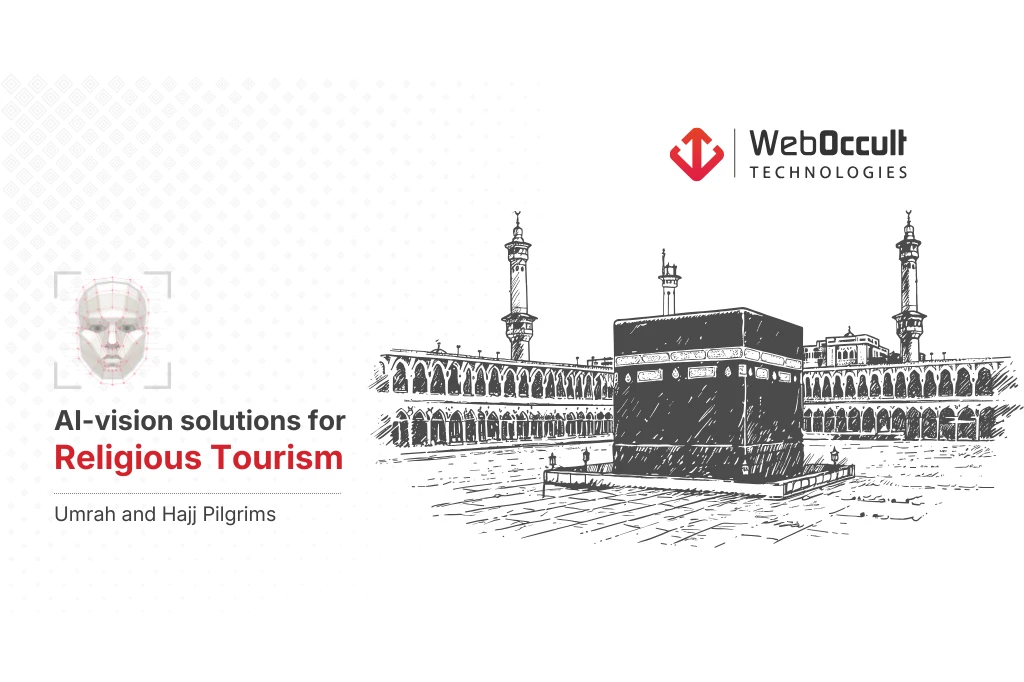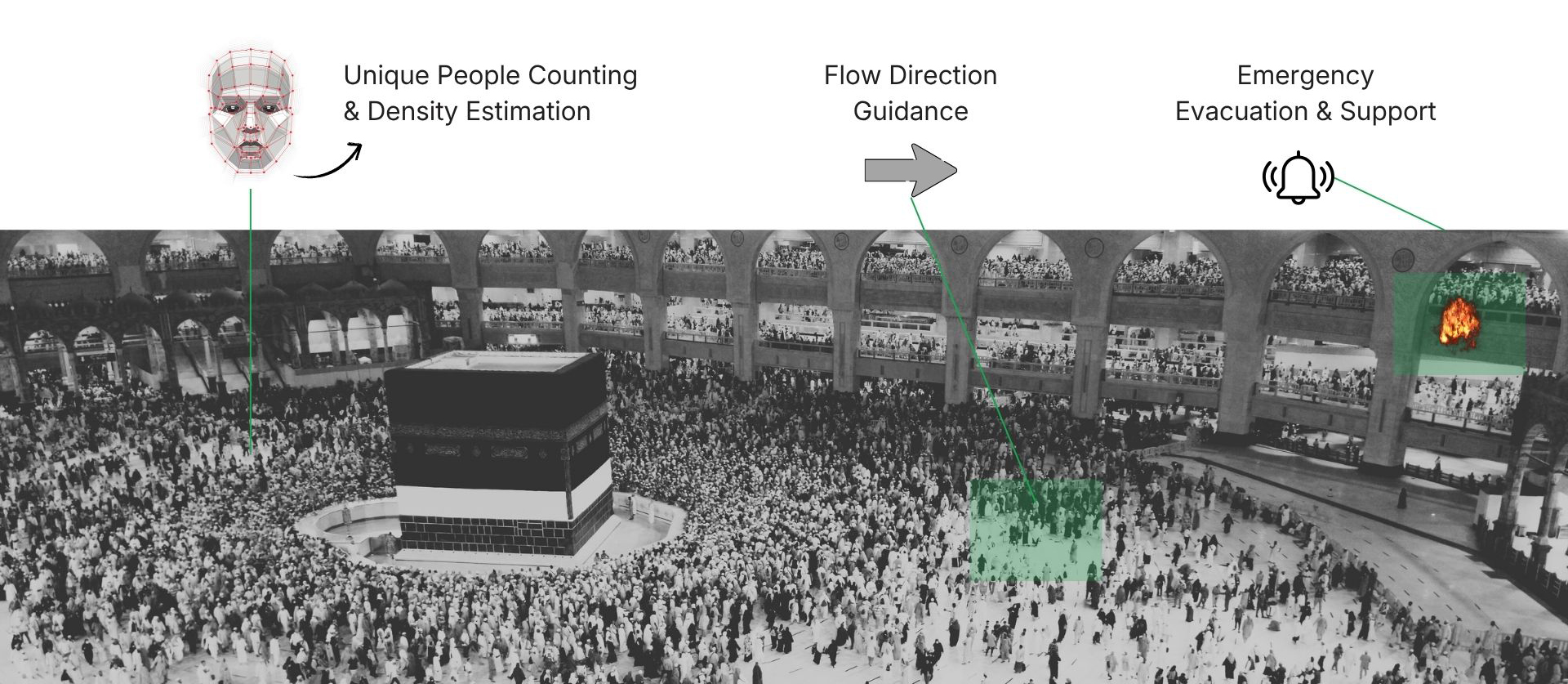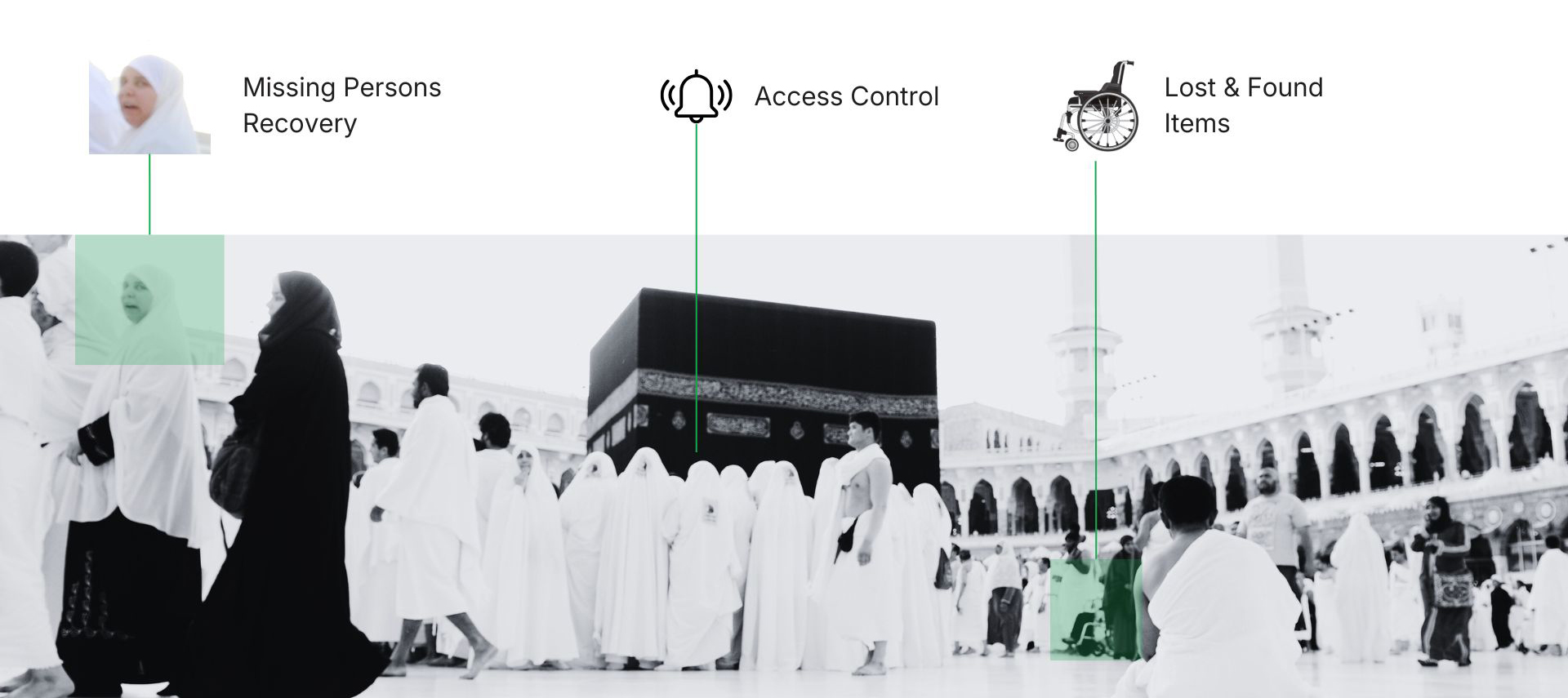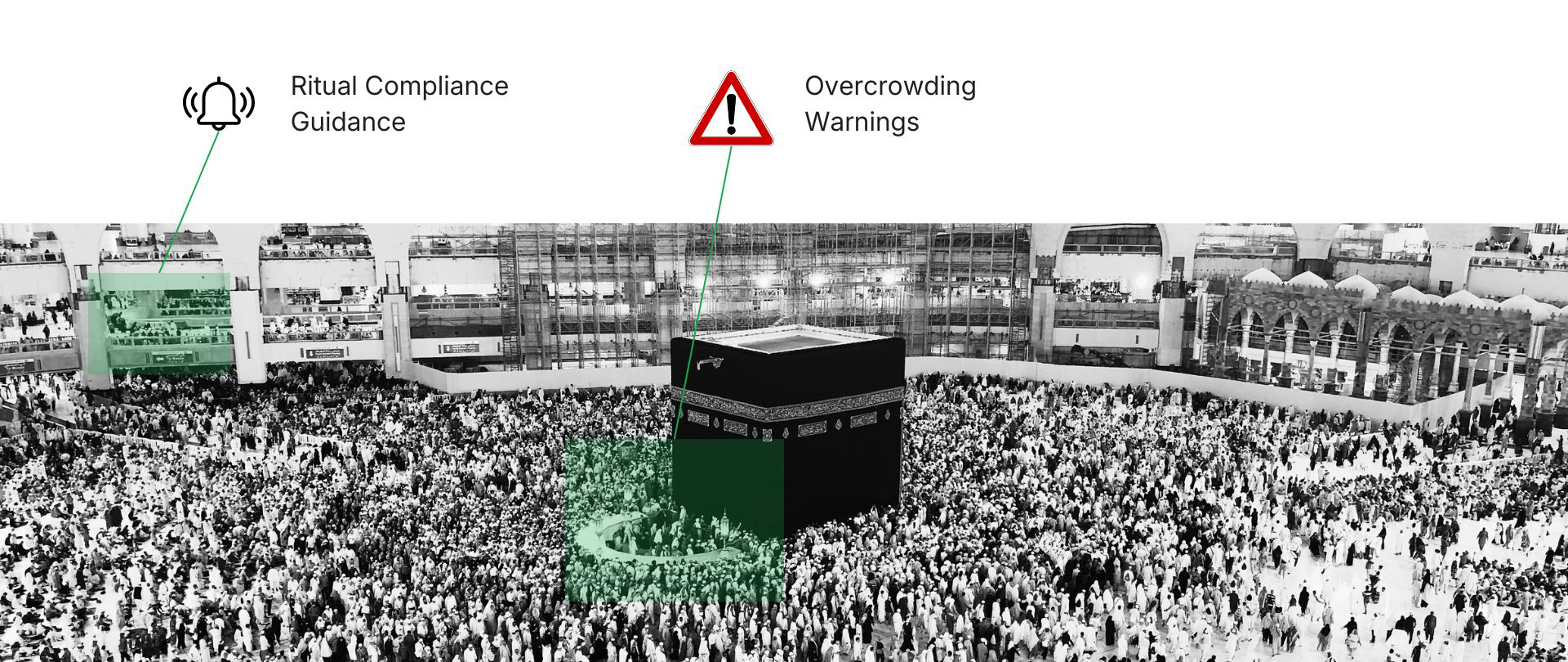Enhancing Pilgrim Management and Safety with AI-Powered Vision Solutions

Ruchir Kakkad
CEO & Co-founder

The annual Hajj and Umrah pilgrimages draw millions of worshippers to the holy sites of Mecca and Medina. It makes them among the largest human gatherings in the world.
Managing these large crowds is a monumental challenge, with safety and security as top priorities. Overcrowding, lost persons, and potential security threats are constant concerns for organizers and authorities.
In recent years, technology advances in real-time image & video analytics and AI-driven vision solutions have opened new roads to tackle these challenges. Governments and event planners are using religious tourism analytics, including AI-enabled monitoring, object detection & tracking, and event detection, to optimize pilgrim management and ensure a safer, smoother experience for all pilgrims. For example, Saudi Arabia has begun deploying advanced AI systems to improve operational efficiency and safety for millions of pilgrims.
This blog explores how various AI and computer vision technologies, implemented with edge AI for low latency and with careful privacy and security compliance, can enhance crowd control, safety, and overall management of Hajj, Umrah, and other large religious events, like Mahakumbh, recently held in India.
We will also look into key solution areas such as crowd flow optimization, AI-powered people counting, biometric identification, missing person tracking, zone-based density tracking, threat detection, and even smart parking for pilgrims. By understanding these innovations, stakeholders, from tech-savvy planners to government authorities and religious tourism organizers, can better appreciate the value of movement guidance solutions and intelligent surveillance in creating a safer pilgrimage journey.

Effective crowd management during Hajj and Umrah is similar to pilgrim traffic control on a massive scale. AI-driven systems analyze live video feeds from thousands of CCTV cameras in and around holy sites to monitor crowd density, movement patterns, and congestion in real time.
As one recent analysis notes, AI algorithms can now track pilgrim movements, monitor crowd density, and identify potential bottlenecks in real time, providing valuable insights to human operators. This data-driven approach to crowd management means decisions, like opening additional gates or re-routing groups, can be made based on real-time evidence rather than intuition.
The result is a more balanced distribution of pilgrims across the site, reducing the risk of chokepoints and improving overall comfort.
A main point of managing large gatherings is knowing exactly how many people are in each area at any particular time. Traditional manual counting is not sufficient for events on the scale of Hajj.
This is where AI-powered people counting comes in. Using object detection & tracking, smart camera systems can count individual pilgrims even in densely packed scenes, and importantly, differentiate unique individuals to avoid double-counting as people move between zones.
The combination of unique people counting and density estimation forms the basis of many religious tourism analytics dashboards, giving planners a live crowd census throughout the event. By deploying these AI-powered counting solutions at the edge (e.g., on AI-based cameras or local gateway devices), organizations ensure low-latency updates without relying on cloud connectivity, a crucial factor when millions of mobile devices and cameras compete for bandwidth.
In practice, AI-powered people counting allows Hajj management teams to allocate resources efficiently (like water, shade, or volunteer staff to crowded spots) and to enforce capacity limits before comfort turns into risk.
Managing not just the volume of people but their direction of travel is another key to smooth pilgrim flow.
During rituals like Tawaf (circling the Kaaba), maintaining a flow in only one direction is critical, and any counter-flow or sudden stop can cause dangerous situations. AI-based movement guidance solutions tackle this by detecting the direction of crowd movement and identifying anomalies. If a group of pilgrims starts moving against the expected direction or an individual is accidentally going the wrong way, the system can immediately alert operators. By analyzing patterns over time, AI systems help optimize one-way routes and walking paths, for instance, staggering group departures to reduce intersections of flows.
Ultimately, by keeping everyone moving in the right direction, the pilgrimage rituals can be performed safely and on schedule, without chaotic interruptions.
In massive gatherings, emergencies can take many forms, a sudden medical incident, a small fire, or a structural problem. They also demand rapid response to avoid escalation.
Real-time video analytics play a crucial role in emergency evacuation and support during pilgrimages. AI systems continuously scan for signs of distress or danger: for example, detecting a crowd crush forming, spotting a person who has collapsed, or recognizing smoke and fire. When a critical event is detected, the system can instantly alert emergency responders and suggest optimized actions.
AI-driven analysis helps identify crowd flow and density to pinpoint trapped areas, ensuring no section with people in danger is overlooked.
By combining computer vision with predictive modeling, authorities can not only respond to incidents but even anticipate them, for instance, detecting that a certain area is nearing a critical density and proactively initiating crowd thinning or evacuation before an accident occurs. Ultimately, these technologies save lives by giving emergency support teams the timely information and guidance they need to act decisively amid chaos.

Managing millions of pilgrims is not just about crowds, but also about individuals, verifying identities, ensuring only authorized persons enter certain areas, and quickly identifying people when needed.
Facial recognition and biometric identification technologies have started playing a major role in pilgrim management. Using AI-driven facial recognition cameras at checkpoints, entrances, and key sites, authorities can rapidly match a pilgrims face against a database of authorized Hajj registrants or visa holders. This enables automated identity verification for entry into venues, access to services, or accommodation check-ins without the need for manual ID checks.
Biometric wearables and IDs (such as fingerprint scans or the Digital Nusuk Card and smart Hajj bracelets also introduced by Saudi authorities.) complement vision-based recognition, creating a comprehensive access control system. Its worth noting that all these implementations come with a responsibility to protect personal data, strict privacy and security compliance measures are essential.
Amid the sea of people during Hajj or Umrah, its common for individuals, especially the elderly or children, to get separated from their groups. Swiftly reuniting lost pilgrims with their companions or tour groups is a critical safety and service issue.
AI-based video analytics can dramatically improve missing persons recovery and lost person tracking. When a person is reported missing, authorities can input identifying characteristics (appearance, clothing color, or better yet a photo) into a computer vision consulting system that searches across live camera feeds and recorded footage. Modern systems use a combination of facial recognition and person re-identification (ReID) algorithms to scan for matches.
Additionally, AI analysis of crowd movement can detect if someone is moving in an unusual pattern that might indicate disorientation (such as a lone individual constantly changing direction in a searching manner). That could trigger a proactive check by nearby security personnel.
Lost person tracking solutions were successfully piloted in recent years, leveraging the massive network of surveillance cameras around the holy sites.
AI-driven lost person tracking provides peace of mind that even in such enormous gatherings, anyone who goes missing can be found and helped as quickly as possible.
Not every area in a pilgrimage site is open to all pilgrims at all times. There are secure zones, such as control rooms, VIP sections, medical facilities, or gender-specific areas, that require strict access control.
Traditionally, guarding these zones relies on human guards checking badges or permits. Now, video analytics and IoT-based solutions are augmenting security at these checkpoints. Restricted area monitoring cameras can automatically verify if a person attempting to enter a zone has authorization. This may be achieved by facial recognition or by detecting an authorized badge or QR code on the person.
If someone without authorization crosses a virtual boundary, the system raises a real-time alert (secure zone entry violation) so security personnel can respond immediately.
This level of automated secure entry management was practically unthinkable a decade ago, but today its increasingly standard in large-scale events and is being tailored for the unique needs of pilgrimages.
Beyond people, another challenge in massive pilgrimages is handling lost belongings.
Every year, thousands of items, phones, bags, identification documents, wheelchairs, etc., are misplaced or left behind by pilgrims. Video analytics can assist in lost and found item recovery by detecting unattended objects and tracing their owners. Abandoned object recognition algorithms can scan camera feeds for items that have been left in one place for too long without an owner. For instance, if a bag is left unattended in a courtyard, the system flags it. This serves a dual purpose: it could be a security threat (suspicious package) or simply a lost item.
In either case, authorities can respond quickly, security teams can safely remove and inspect it. AI can then help match lost item reports with found objects. Suppose a pilgrim reports a lost red backpack; the system can review video footage to see if a red backpack was picked up by someone else or turned in to officials. In the event someone mistakenly walks away with another pilgrims bag, object tracking can follow the items movement across cameras and help locate the person who has it.
In sum, smart item recovery systems keep pilgrim belongings safer and reduce the burden on lost-and-found offices during events.

The spiritual rituals of Hajj and Umrah are deeply significant and must be performed in specific ways. Technology is now helping authorities and scholars ensure these rites are carried out smoothly and respectfully by monitoring pilgrim behavior and ritual performance.
Computer vision can observe patterns in how pilgrims move and behave during rituals, which can be useful for both management and research. For example, during the Stoning of the Devil (Rami al-Jamarat), cameras with AI might watch the crowd for any dangerous behaviors, such as pilgrims throwing objects improperly or climbing on railings, and alert security to intervene for safety. Similarly, during Tawaf, AI ritual observation systems can monitor if the crowd flow around the Kaaba remains uniform and if anyone appears to be in distress (perhaps someone slowing down suddenly due to exhaustion or heat).
With edge AI deployments at the site, these insights come in real-time. Moreover, respectful monitoring of rituals (without invading privacy) can also help religious authorities understand if pilgrims are completing the rites correctly.
Its a fine example of technology assisting tradition, ensuring every pilgrim can fulfill their duties in the proper manner.
In line with behavior monitoring, ritual compliance guidance takes a more active role – using AI to guide pilgrims in real time so that they perform religious rites correctly and efficiently.
This is an emerging area where AI overlaps with educational outreach and on-site assistance. AI ritual observation systems essentially act like a virtual guide or guardian, observing the key steps of rituals and providing feedback or instruction when needed. Consider the Umrah pilgrimage, which involves a sequence of rituals.
On the ground, computer vision consulting teams have been working on systems that use cameras to observe collective rituals and identify any deviations. For example, if a group of pilgrims were to inadvertently start the stoning ritual at the wrong pillar or outside the allotted time window, the system could catch this and notify officials to provide corrective guidance.
Such guided experiences would help maintain compliance with religious requirements.
One of the gravest dangers during Hajj has historically been overcrowding leading to stampedes or crushes. Preventing such tragedies is a paramount goal of any modern pilgrim management system.
AI-powered overcrowding warning systems keep constant watch on crowd densities in every zone and issue timely alerts before a situation becomes critical. As mentioned earlier, video analytics can automatically detect unusually high crowd density in specific areas and notify authorities for intervention.
This is typically implemented by setting threshold levels for each zone based on capacity and historical data, for example, if the area around the Jamarat pillars exceeds a certain number of people per square meter, an alarm is triggered in the command center. In response, officials might temporarily halt additional pilgrims from entering that area, redirect new arrivals to alternative routes, or announce a pause in the ritual until density reduces.
This is arguably one of the most lifesaving applications of AI in religious tourism today.
Large religious events unfortunately can attract security risks, from petty theft and lost items to more serious threats like terrorism. AI-driven surveillance enhances security by providing automatic threat detection across the venue. Here are some key security-focused capabilities:
All these capabilities work in sync to create an AI-driven safety net. The moment something is abnormal, be it a person acting oddly or an object where it shouldnt be, alerts go to the Integrated Command Center and to officers mobile devices.
In the words of experts, AI vision adds an extra layer of vigilance to large events, helping prevent fights, stampedes, or other incidents through early detection.
The convergence of real-time video analytics, AI, and smart vision is revolutionizing pilgrim management and safety for events like Hajj and Umrah.
From guiding millions of people through sacred rituals to tracking objects, these technologies provide a level of insight and control that was impossible in the past. Religious tourism analytics solutions now encompass everything from crowd density monitoring and zone-based density tracking, to biometric identification of pilgrims, to advanced loitering detection and abandoned object recognition for security.
The result is a safer, more organized, and more fulfilling experience for pilgrims.
At WebOccult, we specialize in tailoring these advanced solutions to your needs, from smart crowd management systems to secure access control and beyond.
Our experts can consult on deploying privacy-aware, low-latency edge AI systems that transform how you handle large crowds and complex events. If your involved in organizing religious tourism or any mass gathering, reach out to us to discover how AI and computer vision can empower your pilgrim traffic control and safety initiatives.